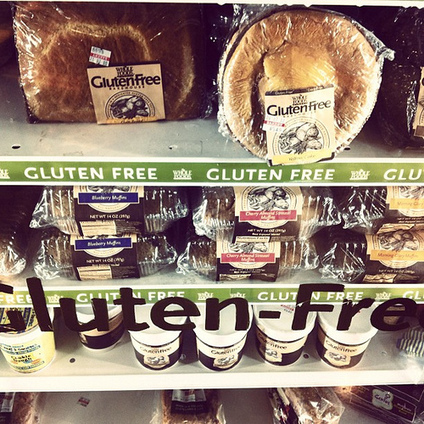How Avoiding Gluten Can Help You Get Healthier and Happier
“Gluten-free” may be the defining trend in food for the past decade. With an uptick in the number of celiac disease diagnoses and the proliferation of low-carb or no-grain diets like Atkins or Paleo, respectively, gluten is certainly on the nation’s collective food consciousness. Gluten also hints of controversy: for Celiacs it’s fine to avoid gluten, but how can everyone else turn their backs on the Agricultural Revolution?!
What is Gluten?
Wikipedia says—and we’re going to assume that at the hands of many scientists this is an accurate description—“Gluten is the composite of a gliadin and a glutelin, which is conjoined with starch in the endosperm of various grass-relatedgrains. The prolamin and glutelin from wheat (gliadin, which is alcohol-soluble, and glutenin, which is only soluble in dilute acids or alkalis) compose about 80% of the protein contained in wheat seed. Being insoluble in water, they can be purified by washing away the associated starch.”
More people know gluten by the description Mark Sisson, author of The Primal Blueprint, gives: “Gluten is a large, water-soluble protein that creates the elasticity in dough.” It makes bread bread, and as such, birthday parties filled with cake, offices filled with doughnuts, and subways filled with lunch sandwiches.
Why are People Interested in Gluten?
Probably mostly because they like to eat it. But have you ever eaten plain flour? It’s the salt, sugar, and fat that helps shape breadstuffs into breadstuffs that we so adore. And perhaps, if we’re trying to avoid gluten, we can use that knowledge to our advantage.
The Gluten Intolerance Group of North America reports that 1 in 133 people have Celiac disease, which PubMed describes as “a condition that damages the lining of the small intestine and prevents it from absorbing parts of food that are important for staying healthy. The damage is due to a reaction to eating gluten, which is found in wheat, barley, rye, and possibly oats.”
Many experts believe that gluten affects everyone in that manner, not just celiacs. At the least, Sisson, who also writes Mark’s Daily Apple, reports, “Gluten sensitivity or intolerance, once thought to be rare, is now believed to affect a third of the population. (Some believe this number is substantially higher.)”
Robb Wolf, author of The Paleo Solution, is less gentle, saying, “Everyone has CXCR3, everyone transports gluten into the enterocytes, everyone experiences gut irritation from gluten.”
If that’s not enough to make you want to quit gluten altogether, consider that ingesting gluten leads to inflammation, which can cause a host of issues from weight gain to malnutrition, decreased cognitive abilities to low energy while spiking blood sugar and taxing many of the body’s systems.
How to Go G-Free
Gluten-free labels are as common as any other these days, but these products often sub other grains for the missing gluten, and/or add in fat and sugar to make up for taste or texture changes—you’ve got to be vigilant about reading labels. It may be better or easier for some to simply rethink the way we prepare food. Lettuce wraps replace sandwiches, throwing food together in a skillet makes a delicious dinner, and you really can eat anything for breakfast.
Wolf and Sisson are just two of the principal luminaries of the Paleo Diet, along with Dr. Loren Cordain, Art De Vany, and Paul Jaminet and Shou-Ching Jaminet (for a rundown of their personal philosophies, check this great breakdown). Most iterations of the paleo or primal diet allow for no grains at all.
Sisson writes in The Primal Blueprint, “What’s less accepted and therefore more insidious as a dietary ‘poison’ are processed grains (wheat and flour products, such as bread, pasta, crackers, snack foods, baked goods, etc. as well as rice, corn, cereals, etc.). You hear right—these staples of diets across the globe are generally inappropriate for human consumption for the simple reason that our digestive systems (and our genes) have not had ample time to adapt to both the unfamiliar protein structure of grains and the excessive carbohydrate load of all forms of cultivated grains, including even whole grains.”
It’s worth noting: a low carb diet is very different from a gluten- or grain-free one. Carbohydrates are found—and sometimes in high concentrations—in all sorts of unprocessed and gluten-free foods including vegetables, fruits, and potatoes.
Whether or not you choose to eschew all grains or just the ones with gluten in them (wheat, rye, barley), you have plenty of support. The gluten-free foods industry’s growth hasn’t slowed a bit since marketers began tracking it, and recipes and cookbooks abound. For more support, click on our Pinterest board: We Don’t Need No Stinkin’ Gluten for creative twists on your old favorite recipes or to discover new faves! More energy, less bloat, and the fun of trying new food combos? Sounds like a recipe for happiness!
Image: Some rights reserved by Andrew-Hyde

